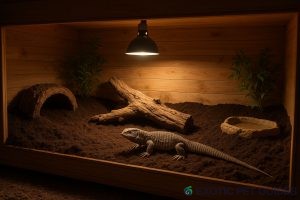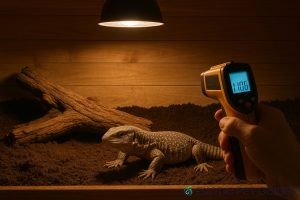Introduction
Savannah Monitors are impressive lizards known for their stocky build and powerful digging behavior. Native to sub-Saharan Africa, these reptiles can grow up to 3-4 feet and require a significant amount of space, heat, and care. If you’re thinking of keeping a Savannah Monitor, here’s everything you need to know to get started on the right foot.
Enclosure Size and Setup
Savannah Monitors need very large enclosures — ideally at least 8 ft x 4 ft x 4 ft for a single adult. This allows them to walk, dig, and thermoregulate properly.
- For juveniles, a 40–75 gallon tank may suffice temporarily.
- The enclosure should include a secure lid, climbing branches, and a deep digging area.

Heating and Lighting
Savannah Monitors are heliothermic—they bask in high heat for digestion and health.
- Basking spot: 130–150°F (54–66°C)
- Cool side: 75–85°F (24–29°C)
- Ambient daytime: 90–100°F (32–38°C)
Use halogen flood bulbs or ceramic heat emitters with a thermostat to maintain temperatures. Full-spectrum UVB lighting is essential to prevent metabolic bone disease.

Substrate and Humidity
The key to a healthy Savannah Monitor is deep substrate (8–12 inches) that allows for burrowing. Ideal substrates include:
- Soil and sand mix (70% organic topsoil, 30% play sand)
- Coconut fiber or cypress mulch as alternatives
Maintain 50–70% humidity by misting the enclosure and providing a large water bowl.

Hides and Decor
Provide multiple hides:
- A warm hide near the basking area
- A cool hide on the opposite end
- Additional decor like cork logs and rocks improve mental stimulation and help with nail wear.

Common Mistakes to Avoid
- Too-small enclosures
- Incorrect heat gradient
- Improper substrate (like reptile carpet or bare glass)
- No UVB lighting
These mistakes can lead to lethargy, improper digestion, and serious health issues.
Conclusion
Caring for a Savannah Monitor isn’t for the faint of heart, but with the right knowledge and setup, these lizards can be rewarding and impressive pets. Always research thoroughly and make sure you’re prepared for the commitment before bringing one home.